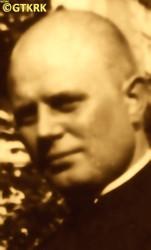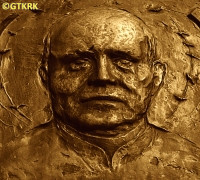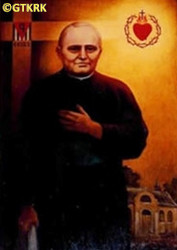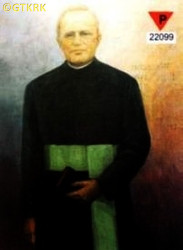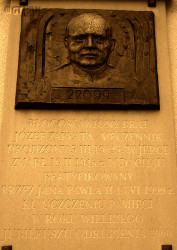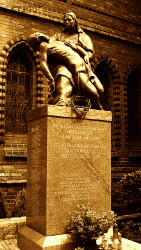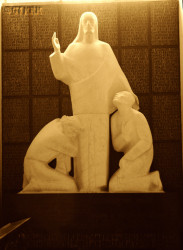Roman Catholic
St Sigismund parish
05-507 Słomczyn
85 Wiślana Str.
Konstancin deanery
Warsaw archdiocese, Poland
full list:
displayClick to display full list

searchClick to search full list by categories
wyświetlKliknij by wyświetlić pełną listę po polsku

szukajKliknij by przeszukać listę wg kategorii po polsku

Martyrology of the clergy — Poland
XX century (1914 – 1989)
personal data
religious status
blessed
surname
ZAPŁATA
forename(s)
Joseph (pl. Józef)
religious forename(s)
Dominic (pl. Dominik)
beatification date
13.06.1999more on
www.swzygmunt.knc.pl
[access: 2013.05.19]

the RC Pope John Paul IImore on
en.wikipedia.org
[access: 2014.09.21]
function
laybrother
creed
Latin (Roman Catholic) Church RCmore on
en.wikipedia.org
[access: 2014.09.21]
congregation
Congregation of Lay Brothers of Heart of Jesus CFCImore on
pl.wikipedia.org
[access: 2013.05.19]
(i.e. Heart of Jesus Brothers)
date and place
of death
19.02.1945

KL Dachauconcentration camp
today: Dachau, Upper Bavaria reg., Bavaria state, Germany
more on
en.wikipedia.org
[access: 2016.05.30]
details of death
After German and Russian invasion of Poland in 09.1939 and start of the World War II, after start of German occupation, took up the post of porter at abandoned Archbishop's house in Poznań.
There arrested by the Germans on 03.10.1939.
Jailed in KL Posen (VII) concentration camp.
Next kept IL Bischofsfelden transit camp in Kazimierz Biskupi.
On 24.05.1940 transported to KL Dachau concentration camp and from there on 02.08.1940 to KL Mauthausen‐Gusen concentration camp where he slaved in quarries.
Finally on 08.12.1940 brought back, totally exhausted, to KL Dachau concentration camp where perished: when typhus fever epidemic broke out in the concentration camp voluntarily agreed to tend to the victims — together with him c. 32 other Polish priests volunteered, among them Fr Stephen Vincent Frelichowski who was the inspiration behind this ministry, Fr Paul Januszewski, Fr Sigismund Mikołajewski, Fr George Stanislav Musiał, Fr Stephen Zielonka and at least one German priest, Fr Richard Henkes.
prisoner camp's numbers
11057, 22099Click to display source page (KL DachauClick to display the description)
cause of death
extermination: exhaustion, starvation, typhus
perpetrators
Germans
sites and events
KL DachauClick to display the description, KL Mauthausen‐GusenClick to display the description, KL PosenClick to display the description, IL BischofsfeldenClick to display the description, Ribbentrop‐MolotovClick to display the description, Pius XI's encyclicalsClick to display the description
date and place
of birth
05.03.1904Birth certification on:
photos.szukajwarchiwach.gov.pl
[access: 2025.03.01]

Jerkatoday: Krzywiń gm., Kościan pov., Greater Poland voiv., Poland
more on
en.wikipedia.org
[access: 2021.12.18]
parents
ZAPŁATA Michael
🞲 ?, ? — 🕆 ?, ?

WOSKOWIAK Marianne
🞲 ?, ? — 🕆 ?, ?
religious vows
08.09.1928 (temporary)
10.03.1938 (permanent)
positions held
1937 – 1939
superior — Poznańtoday: Poznań city pov., Greater Poland voiv., Poland
more on
en.wikipedia.org
[access: 2021.07.18] ⋄ Congregation's house (at 6 Ostrów Tumski), Heart of Jesus' Brothers CFCI — ministry in the Archbishop's Curia and in the Chancellery of the Primate of Poland, August Cardinal Hlond
1935 – 1937
superior — Lvivtoday: Lviv urban hrom., Lviv rai., Lviv obl., Ukraine
more on
en.wikipedia.org
[access: 2022.01.16] ⋄ Congregation's house, Heart of Jesus' Brothers CFCI — sacristan at the St Elizabeth church, master of the novitiate
1929 – 1935
friar — Poznańtoday: Poznań city pov., Greater Poland voiv., Poland
more on
en.wikipedia.org
[access: 2021.07.18] ⋄ Congregation's house (at 6 Ostrów Tumski), Heart of Jesus' Brothers CFCI — ministry in the Archbishop's Curia and in the Chancellery of the Primate of Poland, August Cardinal Hlond
c. 1927 – c. 1929
novitiate — Poznańtoday: Poznań city pov., Greater Poland voiv., Poland
more on
en.wikipedia.org
[access: 2021.07.18] ⋄ Congregation's house (at 6 Ostrów Tumski), Heart of Jesus' Brothers CFCI
14.04.1927
accession — Puszczykowotoday: Puszczykowo urban gm., Poznań pov., Greater Poland voiv., Poland
more on
en.wikipedia.org
[access: 2021.07.25] ⋄ General House, Heart of Jesus' Brothers CFCI
others related
in death
FRELICHOWSKIClick to display biography Steven Vincent, HENKESClick to display biography Richard, JANUSZEWSKIClick to display biography Paul (Fr Hillary), MIKOŁAJEWSKIClick to display biography Sigismund, MUSIAŁClick to display biography George Stanislav, ZIELONKAClick to display biography Steven
sites and events
descriptions
KL Dachau: KL Dachau in German Bavaria, set up in 1933, became the main German Germ. Konzentrationslager (Eng. concentration camp) KL for Catholic priests and religious during World War II: On c. 09.11.1940, Reichsführer‐SS Heinrich Himmler, head of the SS, Gestapo and German police, as a result of the Vatican's intervention, decided to transfer all clergymen detained in various concentration camps to KL Dachau camp. The first major transports took place on 08.12.1940. In KL Dachau Germans held approx. 3,000 priests, including 1,800 Poles. The priests were forced to slave labor in the Germ. „Die Plantage” — the largest herb garden in Europe, managed by the genocidal SS, consisting of many greenhouses, laboratory buildings and arable land, where experiments with new natural medicines were conducted — for many hours, without breaks, without protective clothing, no food. They slaved in construction, e.g. of camp's crematorium. In the barracks ruled hunger, freezing cold in the winter and suffocating heat during the summer, especially acute in 1941‐1942. Prisoners suffered from bouts of illnesses, including tuberculosis. Many were victims of murderous „medical experiments” — in 11.1942 c. 20 were given phlegmon injections; in 07.1942 to 05.1944 c. 120 were used by for malaria experiments. More than 750 Polish clerics where murdered by the Germans, some brought to TA Hartheim euthanasia centre set up in Schloss Hartheim in Austria and murdered in gas chambers. At its peak KL Dachau concentration camps’ system had nearly 100 slave labour sub‐camps located throughout southern Germany and Austria. There were c. 32,000 documented deaths at the camp, and thousands perished without a trace. C. 10,000 of the 30,000 inmates were found sick at the time of liberation, on 29.04.1945, by the USA troops… (more on: www.kz-gedenkstaette-dachau.deClick to attempt to display webpage
[access: 2013.08.10], en.wikipedia.orgClick to attempt to display webpage
[access: 2016.05.30])
KL Mauthausen‐Gusen: A large group of German Germ. Konzentrationslager (Eng. concentration camp) KL camps set up around the villages of Mauthausen and Gusen in Upper Austria, c. 30 km east of Linz, operational from 1938 till 05.1945. Over time it became of the largest labour camp complexes in the German‐controlled part of Europe encompassing four major camps concentration camps (KL Mauthausen, KL Gusen I, KL Gusen II and KL Gusen III) and more than 50 sub‐camps where inmates slaved in quarries — the granite extracted, previously used to pave the streets of Vienna, was intended for a complete reconstruction of major German towns according to the plans of the chief architect of National Socialist Germany, the Germ. Generalbauinspektor für die Reichshauptstadt (Eng. General Building Inspector for the Reich Capital) and from 1942 also, i.a. the Germ. Reichsminister für Bewaffnung und Munition (Eng. Reich Minister for Armaments and Ammunition), Albert Speer — munitions factories, mines, arms factories and Me 262 fighter‐plane assembly plants. The complex served the needs of the German war machine and also carried out extermination through labour. Initially did not have a its own gas chamber and the intended victims were mostly moved to the infamous euthanasia center in the Schloss Hartheim castle w Alkoven, 40.7 km east, or killed by lethal injection and cremated in the local crematorium. Later a van with the exhaust pipe connected to the inside shuttled between KL Mauthausen and KL Gusen. In 12.1941 a permanent gas chamber was built. C. 122,000‐360,000 of prisoners perished. Many Polish priests were held, including those captured during the program of extermination of Polish intelligentsia («Intelligenzaktion»). The camp complex was founded and run as a source for cheap labour for private enterprise. (more on: en.wikipedia.orgClick to attempt to display webpage
[access: 2014.03.10])
KL Posen: German Posen — Fort VII — camp founded in c. 10.10.1939 in Poznań till mid of 11.1939 operated formally as Germ. Konzentrationslager (Eng. concentration camp) KL Posen, and this term is used throughout the White Book, also later periods. It was first such a concentration camp set up by the Germans on Polish territory — in case of Greater Poland (Wielkopolska) directly incorporated into German Reich. In 10.1939 in KL Posen for the first time Germans used gas to murder civilian population, in particular patients of local psychiatric hospitals. From 11.1939 the camp operated as German political police Gestapo prison and transit camp (Germ. Übergangslager), prior to sending off to concentration camps, such as KL Dachau or KL Auschwitz. In 28.05.1941 the camp was rebranded as police jail and slave labour corrective camp (Germ. Arbeitserziehungslager). At its peak up to 7‐9 executions were carried in the camp per day, there were mass hangings of the prisoners and some of them were led out to be murdered elsewhere, outside of the camp. Altogether in KL Posen Germans exterminated approx. 20,000 inhabitants of Greater Poland (Wielkopolska) region, including many representatives of Polish intelligentsia, patients and staff of psychiatric hospitals and dozen or so Polish priests. Hundreds of priests were held there temporarily prior to transport to other concentration camps, mainly KL Dachau. From 03.1943 the camp had been transformed into an industrial complex (from 25.04.1944 — Telefunken factory manufacturing radios for submarines and aircrafts). (more on: www.wmn.poznan.plClick to attempt to display webpage
[access: 2019.02.02], en.wikipedia.orgClick to attempt to display webpage
[access: 2013.12.27])
IL Bischofsfelden: The Gestapo District Office in Poznań issued on 13.12.1939 executive instruction Ref. IIB No. 406/39 Tgb. No. 3045/39, ordering: „Based on the regulation of the Germ. Höherer SS‐ und Polizeiführer (Eng. Higher Commander of the SS and Police) [of the German province of Warthegau (Eng. Greater Poland)] of 12.11.1939 [SS‐Gruppenführer Wilhelm Koppe], apart from Poles and Jews, also Catholic clergy will be expelled. Action against this group of people should be carried out in such a way that internment and transport are separate […] C. 80% of Catholic clergy are expected to be expelled. The selection based on political threat posed. Internees cannot be placed in regular transit camps due to the possibility of international protest. Catholic clergy should be interned in men's monasteries and held there till mass transportation out”. And so in the Missionary of the Holy Family MSF monastery, in Kazimierz Biskupi village, near Konin, the Germans set up the IL Bischofsfelden transit Germ. „Internierungslager” (Eng. „Internment camp”) for altogether 42 Polish Catholic priests, mainly from Greater Poland (Wielkopolski) — activists of Catholic organizations, canons of the Poznań cathedral chapter, Dominican and Conventual Franciscan friars from Poznań. The camp operated from 09.11.1939 to 26.08.1940. Some of the priests were released by Germans, the rest being transported to German concentration camps, where 8 of them perished. After the liquidation of the camp, the Germans converted the church and monastery into a granary. (more on: regionwielkopolska.plClick to attempt to display webpage
[access: 2013.10.05])
Ribbentrop‐Molotov: Genocidal Russian‐German alliance pact between Russian leader Joseph Stalin and German leader Adolf Hitler signed on 23.08.1939 in Moscow by respective foreign ministers, Mr. Vyacheslav Molotov for Russia and Joachim von Ribbentrop for Germany. The pact sanctioned and was the direct cause of joint Russian and German invasion of Poland and the outbreak of the World War II in 09.1939. In a political sense, the pact was an attempt to restore the status quo ante before 1914, with one exception, namely the „commercial” exchange of the so‐called „Kingdom of Poland”, which in 1914 was part of the Russian Empire, fore Eastern Galicia (today's western Ukraine), in 1914 belonging to the Austro‐Hungarian Empire. Galicia, including Lviv, was to be taken over by the Russians, the „Kingdom of Poland” — under the name of the General Governorate — Germany. The resultant „war was one of the greatest calamities and dramas of humanity in history, for two atheistic and anti‐Christian ideologies — national and international socialism — rejected God and His fifth Decalogue commandment: Thou shall not kill!” (Abp Stanislav Gądecki, 01.09.2019). The decisions taken — backed up by the betrayal of the formal allies of Poland, France and Germany, which on 12.09.1939, at a joint conference in Abbeville, decided not to provide aid to attacked Poland and not to take military action against Germany (a clear breach of treaty obligations with Poland) — were on 28.09.1939 slightly altered and made more precise when a treaty on „German‐Russian boundaries and friendship” was agreed by the same murderous signatories. One of its findings was establishment of spheres of influence in Central and Eastern Europe and in consequence IV partition of Poland. In one of its secret annexes agreed, that: „the Signatories will not tolerate on its respective territories any Polish propaganda that affects the territory of the other Side. On their respective territories they will suppress all such propaganda and inform each other of the measures taken to accomplish it”. The agreements resulted in a series of meeting between two genocidal organization representing both sides — German Gestapo and Russian NKVD when coordination of efforts to exterminate Polish intelligentsia and Polish leading classes (in Germany called «Intelligenzaktion», in Russia took the form of Katyń massacres) where discussed. Resulted in deaths of hundreds of thousands of Polish intelligentsia, including thousands of priests presented here, and tens of millions of ordinary people,. The results of this Russian‐German pact lasted till 1989 and are still in evidence even today. (more on: en.wikipedia.orgClick to attempt to display webpage
[access: 2015.09.30])
Pius XI's encyclicals: Facing the creation of two totalitarian systems in Europe, which seemed to compete with each other, though there were more similarities than contradictions between them, Pope Pius XI issued in 03.1937 (within 5 days) two encyclicals. In the „Mit brennender Sorge” (Eng. „With Burning Concern”) published on 14.03.1938, condemned the national socialism prevailing in Germany. The Pope wrote: „Whoever, following the old Germanic‐pre‐Christian beliefs, puts various impersonal fate in the place of a personal God, denies the wisdom of God and Providence […], whoever exalts earthly values: race or nation, or state, or state system, representatives of state power or other fundamental values of human society, […] and makes them the highest standard of all values, including religious ones, and idolizes them, this one […] is far from true faith in God and from a worldview corresponding to such faith”. On 19.03.1937, published „Divini Redemptoris” (Eng. „Divine Redeemer”), in which criticized Russian communism, dialectical materialism and the class struggle theory. The Pope wrote: „Communism deprives man of freedom, and therefore the spiritual basis of all life norms. It deprives the human person of all his dignity and any moral support with which he could resist the onslaught of blind passions […] This is the new gospel that Bolshevik and godless communism preaches as a message of salvation and redemption of humanity”… Pius XI demanded that the established human law be subjected to the natural law of God , recommended the implementation of the ideal of a Christian state and society, and called on Catholics to resist. Two years later, National Socialist Germany and Communist Russia came together and started World War II. (more on: www.vatican.vaClick to attempt to display webpage
[access: 2023.05.28], www.vatican.vaClick to attempt to display webpage
[access: 2023.05.28])
sources
personal:
zbsj.plClick to attempt to display webpage
[access: 2012.11.23], pl.wikipedia.orgClick to attempt to display webpage
[access: 2012.11.23], photos.szukajwarchiwach.gov.plClick to attempt to display webpage
[access: 2025.03.01], www.ipgs.usClick to attempt to display webpage
[access: 2012.12.28], jzaplata.blogspot.comClick to attempt to display webpage
[access: 2014.03.10]
bibliographical:
„A martyrology of Polish clergy under German occupation, 1939‐1945”, Fr Szołdrski Vladislaus CSSR, Rome 1965
„International Tracing Service (ITS), Bad Arolsen, GermanyClick to display source page”, Arolsen Archives
original images:
150.254.192.234Click to attempt to display webpage
[access: 2013.08.10], www.facebook.comClick to attempt to display webpage
[access: 2025.01.21], www.polskaniezwykla.plClick to attempt to display webpage
[access: 2014.03.10], www.swietyjozef.kalisz.plClick to attempt to display webpage
[access: 2019.05.30], prawy.plClick to attempt to display webpage
[access: 2019.05.30], www.polskaniezwykla.plClick to attempt to display webpage
[access: 2014.03.10], www.szczecin.plClick to attempt to display webpage
[access: 2014.09.21]
LETTER to CUSTODIAN/ADMINISTRATOR
If you have an Email client on your communicator/computer — such as Mozilla Thunderbird, Windows Mail or Microsoft Outlook, described at WikipediaPatrz:
en.wikipedia.org, among others — try the link below, please:
LETTER to CUSTODIAN/ADMINISTRATORClick and try to call your own Email client
If however you do not run such a client or the above link is not active please send an email to the Custodian/Administrator using your account — in your customary email/correspondence engine — at the following address:

giving the following as the subject:
MARTYROLOGY: ZAPŁATA Joseph
To return to the biography press below:
 Click to return to biography
Click to return to biography









